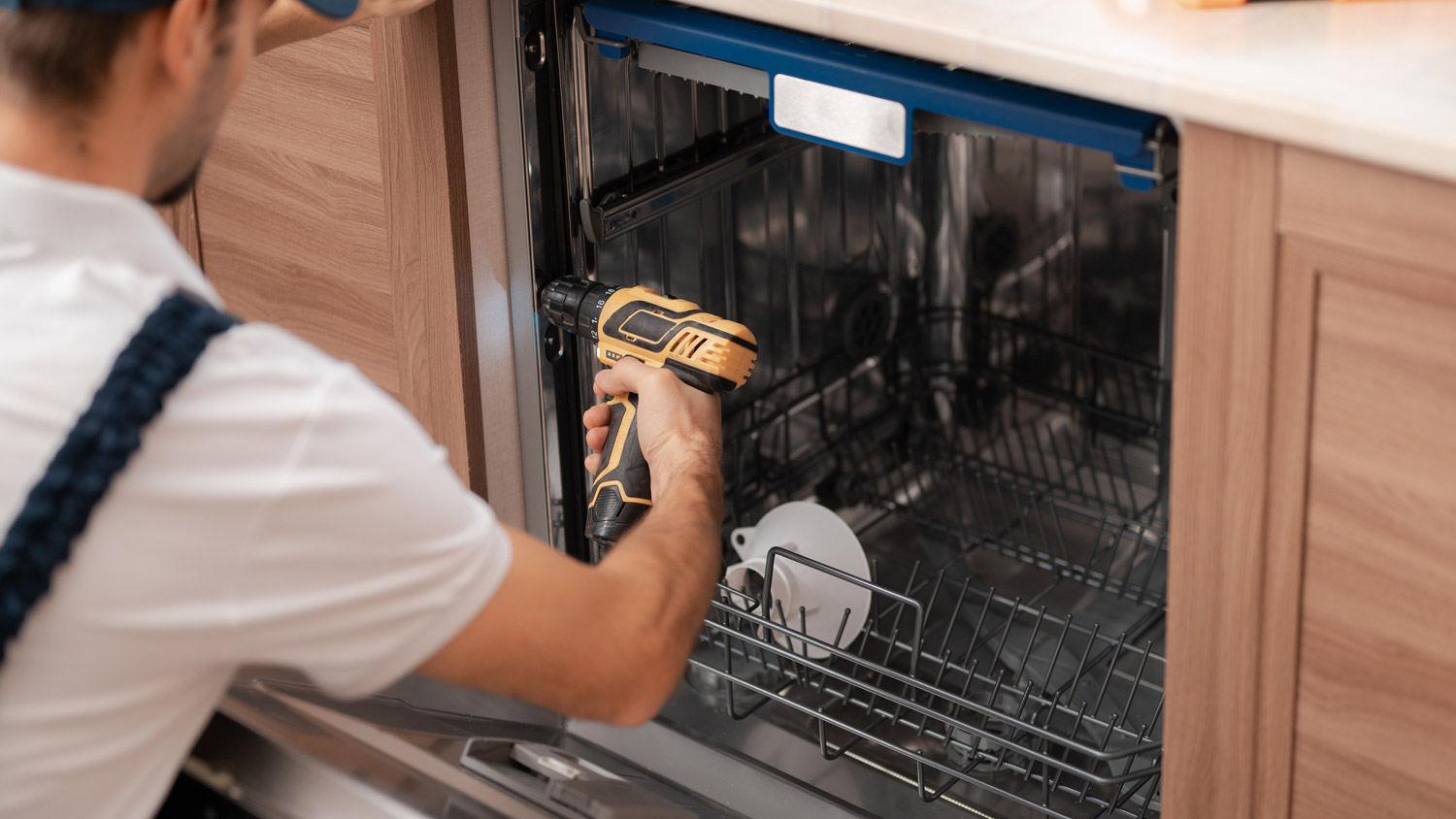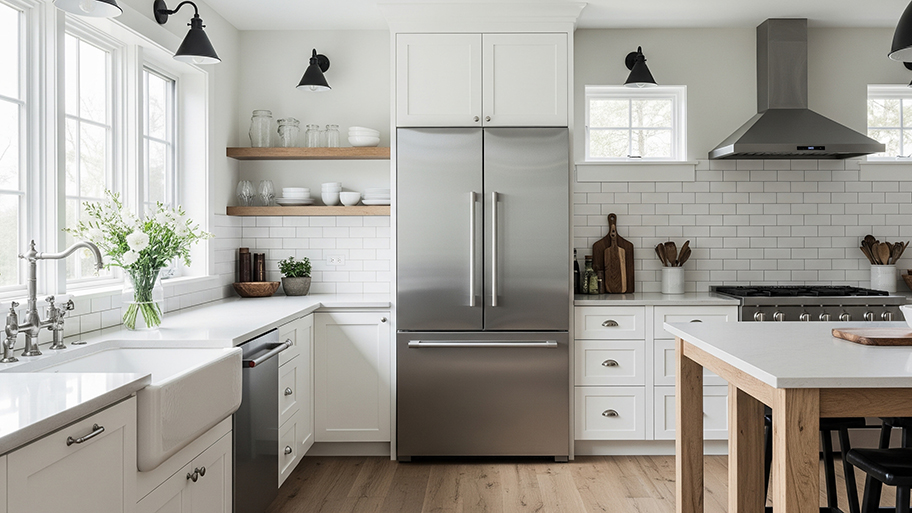
Discover the average dishwasher installation cost, key price factors, and tips to save on your project. Get transparent, expert-backed estimates.
Searing a steak on your stovetop has never been so enjoyable and smoke-free


Range hoods use fans to pull smoke, odors, and grease from the air to make your kitchen cleaner.
Ducted hoods vent air outside, offering better performance but requiring professional installation.
Ductless hoods filter and recirculate air, making them compact and affordable.
If a range hood isn’t an option, protect your cooking space with window fans and grease splatter guards.
Installing a range hood costs around $400 to $1,550.
If you’ve frantically waved a kitchen towel under your smoke detector more often than you’d like to admit, adding a range hood to your kitchen could be your smartest upgrade yet. Whipping up a delicious meal in your kitchen, exhaustless, is ten times harder when working behind a cloud of smoke. The only question is: which type of range hood should you get? There are plenty of options to choose from, all of which will make cooking in your updated kitchen fun again.
Read on to learn more about the types of range hoods available and why every kitchen needs one.
A range hood hangs over your stovetop and captures all of the smoke rising from your pans using a fan or blower motor. Whether you have a ducted or ductless system, the range hood will either expel the air from your home through a duct or filter it and recirculate it back into your home.
If you’re without a range hood now, then you know what it's like to sear food in a smokey mess. A powerful range hood will make sure the essence of Sunday dinners doesn’t linger in your home for days. However, not all range hoods are the same, so you’ll need to consider where you want to install your range hood and the features available to determine which one is optimally suited for your kitchen.
There are many different types of range hoods, each with unique features. While you can chop them up into several different categories, here are some of the most common types.
The most common type of range hood, a wall-mounted, wait for it, mounted to your wall directly over the range, typically between two to three feet above the stove. They come in various shapes and sizes and may be installed against a flat wall or alongside cabinets.
An island range hood is perfect for larger kitchens as it hangs directly from the ceiling over the stove installed on the island. These hoods are not only functional but highly visible in your kitchen. If you choose an island hood range, opt for one that matches your kitchen aesthetic. Such a bold setup is likely to become the centerpiece of your kitchen.
Downdraft hoods are less expensive to install and simply pop up from behind the stove when needed. However, because they are not positioned directly over your stove, they're less effective than other types of range hoods and may not catch all of the smoke and moisture.
Microwave range hoods are particularly common in homes with smaller kitchens where space is at a premium. Here, the range hood is installed underneath the microwave to maximize the use of space. Microwave range hoods are ductless systems (more on this below), so these models will only recirculate air inside your home rather than push the air outside. They’re less effective in ridding strong odors, but they’re more affordable and perfect if you don't have the space for a wall-mounted hood.

All range hoods operate similarly. The vent hood collects steam and grease odors using a fan motor, circulating the air or sending it outside the home. Most hoods have levels of motor speeds you can engage, depending on the amount of smoke. A hood set to a higher speed will work harder to clear the smoke.
Ducted range hoods that send air outside the home will also have a grease filter. Ductless range hoods that recirculate the air will use a charcoal filter.
Among household appliances, a range hood doesn’t hold the same perceived value as your refrigerator or stove. Many homeowners hold a “take it or leave it” attitude as they fan their smoke detectors or air out their kitchen with an open door. But there are several reasons why every kitchen needs a range hood—or at least several reasons why it’s worth considering.
Range hoods can:
Improve air quality in your kitchen and home
Remove smoke, smells, and airborne grease
Create a better cooking experience by removing excess heat
Minimize messes and particle buildup on kitchen surfaces
Increase your property value
The cost to install a range hood is between $400 and $1,550, and while you don’t need a range hood, the investment can add value to your life and your home.
When choosing the right type of vent hood for your kitchen range, there are two exhaust hood options: ducted and ductless. While both use fans to help cut back on smoke, each type of range hood comes with its own set of pros and cons.
Ducted range hoods use ducts to create a ventilation system in the kitchen and help with recirculation. The hood draws fumes from above the stove and sends them outside through mesh or carbon filters, which is the more effective method for eliminating smoke and odor from your kitchen.
These systems typically are larger and more expensive than ductless systems because their fans are more powerful. Ducted models also remove any moisture from the cooktop.
But not every kitchen can install a ducted model. They require more space, preferably near an exterior wall, to work effectively. If your kitchen is cramped and there isn't a duct nearby, you may need to get a smaller ductless model. Also, installation is a bit more complex, so you’d likely have to hire a local contractor to do it right.
Ductless models use suction fans to draw in air and circulate it through a charcoal filter. They still trap grease and some odors, but they’re no match for ducted models. If you’d rather listen to conversation when you cook, rather than the fan on your hood, choose a ducted model whose fan is positioned up in the ductwork rather than just over the stovetop.
The recirculation venting method means your charcoal filter will receive a steady and heavy flow of dirt, so plan on replacing it more often.
That said, ductless hoods are compact and don't need to be hooked up to ducts to work, giving homeowners more options. A smaller overall footprint makes ductless models a great option for apartment and condo dwellers where installing ducts in walls or ceilings may not be possible. They’re also cheaper and easier to install yourself; however, it’s still a DIY project worth passing on to professionals.
A range hood helps improve air quality, remove smoke and odors, and minimize grease buildup on kitchen surfaces. If you’re not sold on a range hood, there are alternatives that can help you achieve the same effects. And while one tool won’t recreate the effects of a range hood, a combination of them can.
Air filters improve air quality by removing pollutants and smoke from a room. Window fans work similarly; however, they give the added benefit of pulling in fresh air from outside while pulling out the stuff in your kitchen that you don’t want—smoke, heat, and smells.
Without a range hood to remove airborne grease, particles travel around your kitchen and build up on your countertops, floors, and more. Grease splatter guards may not match the aesthetic of your kitchen, but neither do greasy surfaces. Splatter guards are temporary shields you can put around your stove to control grease and keep it from getting around your kitchen.
Installing a range hood isn’t a DIY-friendly project. While a ductless range hood is an easier install for a more experienced DIY-er, it’s still better to hire a local range hood installation professional to get the job done. A range hood install, especially one that requires ductwork, needs to be set up with the right connections and vent routes so the air makes its way out of the kitchen. If you don’t want to be stuck with a $1000 range hood and smoke, grease, and odors floating around your kitchen, installing a range hood is a job best left to the professionals.
From average costs to expert advice, get all the answers you need to get your job done.

Discover the average dishwasher installation cost, key price factors, and tips to save on your project. Get transparent, expert-backed estimates.

A wood stove can add warmth and ambiance to your home, but is it in your budget? Discover average wood-burning stove installation costs in this guide.

If your refrigerator has been damaged, refrigerator door dent repair cost will vary based on the imperfection's size, depth, and location. Use our guide to estimate how much you'll spend on refrigerator dent repair.

Now the reasons why your dryer is leaking water and what you can do to prevent further water damage and address the problem.

Dealing with a clogged dishwasher? Use this guide on how to drain a dishwasher to empty it and clear out any debris that’s causing a backup.

Refrigerators comprise many different parts. Understanding what they are and how they function will help you maintain it and troubleshoot problems.